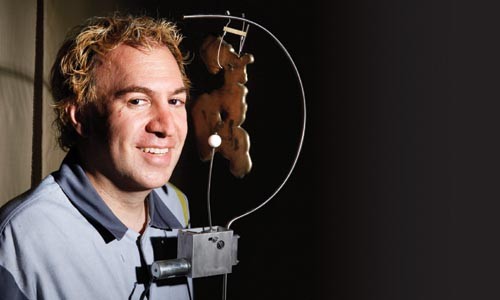Imagine, based on every sci-fi film you've ever seen, a factory that produces robots. Now imagine the opposite, and you're getting close to Eric Singer's workshop -- a dank, low-ceilinged Squirrel Hill basement where he turns out not droid armies, but robotic musical instruments.
There are the power tools: a bench-top mill, a drill press, a band saw. Ranged around are the instruments. Some are being stored, others repaired. Some are still in the process of being invented. On a workbench sits the main mechanism for the XyloBot -- a long rectangle of dark wood, bristling with metal rods and dozens of small mallets. When fully assembled, the mallets strike tuned lengths of plumbing pipe, which generate the clanking, alien overtones Singer prefers to more conventional xylophone sounds.
Nearby is the in-progress HydroBot 1, which Singer says could be called a "hydrocymbal": a cymbal that has water in it, and swirls around once it's struck, changing the timbre. In the shadows, meanwhile, lurks the GuitarBot -- the first robot instrument Singer tackled -- and the Sonic Banana, a two-foot length of flexible hose equipped with sensors and a cord, which can be bent and twisted to control electronic sounds. Playing it, says Singer, "is like DJing with a yellow rubber tube."
Many of the instruments are based on the solenoid, an electromagnetic plunger that moves when current is applied -- in turn moving a drum stick, or plucking a string. Solenoids are commonly used in cars and laundry machines (which can also be found in Singer's basement, beside a pile of laundry).
Rather than passive appliances, the robots here can interact with their surroundings and human musicians. "Any type of action-reaction thing you can conceive of," Singer says, "you can program and create an instrument that you can jam with. Very literally, it's a duet improvisation for human and robot." Earlier this year, famed fusion guitarist Pat Metheny took to the road, with a backing band made up entirely of robots, most created by Singer and a group of collaborators in Brooklyn (see "Going Solo").
They're also a solution to getting music out of the computers and headphones and back into larger, more organic ambiance. "They produce complex acoustic sound that is often lost in the electronic-music versions of these sounds," says Singer. "You can always walk into a room or a club with your eyes closed and know whether you're hearing a live band, or something played back from speakers. And with these, you always know you're hearing a live band."
Well, "live" might not be the right word.
Although Singer is at the forefront of his field, he sees himself as part of a long line of instrument developers. His robots' ancestors, of course, include devices like the player piano and synthesizer. But whenever he can, he visits musical-instrument museums, to draw inspiration from unique, one-of-a-kind instruments that didn't end up popularized and standardized -- instruments "that didn't make it."
"The first person to design a violin probably had some strings from a cat gut, and a pile of wood, and had to come up with a way to make that sound good," he says. "I'm in the same boat. It's just that my toolset is electronics and computers and mechanical parts."
Continuing that legacy may be the only way Singer could ever have satisfied his various interests. A native of Connecticut (which he summarily dismisses as "boring"), Singer attended Carnegie Mellon University, earning a degree in computer engineering in 1988. But he was also a musician -- a saxophonist -- playing jazz and rock in college. Later, he spent 10 years playing in ska bands based in Boston (where he studied at the Berklee College of Music) and New York (where he earned an MA in computer science at New York University).
"Personally, I wouldn't be happy just doing music and not doing engineering, or vice versa," Singer says. "I've been lucky to come up with a way to do both."
Building the robots "was just something that interested me conceptually," he adds. "It was a departure from my previous work -- in fact, I saw it as the flip side of the coin. Instead of causing the computer to make sound, instead of sending data into the computer, you take the data out of the computer and send it to something physical" -- a drum, a xylophone, a guitar. (See sidebar, "GuitarBot.")
That spirit led Singer to found the Brooklyn-based collective LEMUR -- the "League of Electronic Musical Urban Robots" -- as an offshoot of Brooklyn art collective and center Madagascar Institute, in 2000.
Today, LEMUR is a nonprofit that focuses on instrument building and performance; some 100 people have collaborated in the project over the past decade. The group also offers classes on subjects like sensor building, robotics, using various software, music and video.
When Singer set out, though, he had no way to make the robots: "None of my academic training was in anything related to mechanical engineering or robotic engineering." So a friend began showing him how to do machine work, allowing Singer to make the individual custom parts he needed.
LEMUR began working on an impressive number of interrelated projects: concerts with the likes of They Might Be Giants and museum installations (including one at the Children's Museum of Pittsburgh) as well as musical performances. The installations can include projected video and computer visual recognition that allows the work to interact with exhibit visitors. "We brought all of these components together into a cohesive, multi-user, interactive sound and visual environment," Singer says.
Meanwhile, however, Singer's own musicianship took the back seat. "I knew I was gonna have to sacrifice some things, so the saxophone doesn't get touched a lot lately," he says. And although LEMUR was breaking even, he wasn't really making any money: In Brooklyn, LEMUR's combination performance space, gallery, classrooms and electronics lab cost $3,000 a month in rent, plus other upkeep expenses.
Which, more than anything, is what brought Singer to Pittsburgh in August, with his wife Heather and their 6-year-old daughter.
Golan Levin, director of the Center for Creative Inquiry, part of the College of Fine Arts at CMU, had something to do with the move as well. Levin, who himself moved here from New York five years ago, had met Singer at various conferences, and the two had friends in common.
Says Levin, "Eric is really one of the world's foremost robotics artists," and one of the few local artists to be "working on an international stage."
"I think that Pittsburgh is clearly one of the robotics capitals of the world," Levin says, citing both CMU and spinoff companies. What's more, Singer is only paying $300 a month to house his robotics shop and menagerie.
Without the financial pressures and social distractions of New York, "I have that elusive entity known as 'free time,'" marvels Singer. "There's obviously a big technology base here, there's a huge art scene, and there's a huge overlap and interaction between artists and technologists, and people who are both."
But while he's given some lectures and demos here, Singer hasn't performed any concerts and isn't rushing into anything big just yet. "I want to learn who the most interesting people are and collaborate with them," he says. "I also want to kind of cocoon and make some more work for awhile."
Now that he's relocated to Pittsburgh, though, he plans to recruit apprentices and others who want to "learn the craft" of the robots and collaborate with LEMUR, starting in the fall.
"At the moment," he adds, "it's me and the robots, and a few people who I left behind in New York, who help with things when I do shows in New York. But in Pittsburgh, at the moment, it's just me."
And running LEMUR is a full-time job. To stay on top of it, Singer tends to speak in numbered lists, like this checklist of fronts where he and the robots are deployed:
"One is performing live with musicians; two is being installed in a museum and working interactively so other people can play them. Three is building them for other artists, so they can go out and do their thing with them. Four is commissioning working artists, professional artists, composers and musicians to create compositions or live performances with the instruments, and developing acts with those musicians that can go out." At this point, Singer estimates that LEMUR has fabricated more than 100 robotic instruments of varying complexity.
Robotic instruments offer advantages over playing to another kind of backing tracks. For one thing, they can be programmed by any musician or composer with a basic understanding of how standard electronic instruments interact (using Musical Instrument Digital Interface, or MIDI). And they can be played using any type of MIDI controller, such as a keyboard or computer software.
That standardized interface seems partly why Singer's instruments have been so successful -- as multi-media museum installations, stand-alone instruments and even as backing "musicians" for humans.
With a MIDI-equipped instrument, a human musician can play a series of notes that trigger the robots to play notes of their own. These can be stored patterns, looped phrases, even subtly randomized or unpredictable reactions. The robots can be "taught" and programmed, but they can also respond spontaneously.
Singer sees larger musical implications on two levels. First, he sees them as part of "an interleaved lineage" of instrument design. Eventually, he predicts, "I think they will join computers, synths and new acoustic instruments as just part of the band." Secondly, the fact that the robots can tirelessly produce live acoustic sound in an installation is "a significant achievement," he says.
But it isn't always easy finding stages for the robots. They lack charisma, tending to look blocky, solid. Robust design is crucial, since the instruments are designed to perform over months, relatively unattended, in museum settings -- even on the road.
"You shouldn't have an instrument blow up onstage," Singer says. When people think of these kinds of installations or projects, "the expectation, sadly, is that stuff won't work. We have to overcome people's expectation of failure."
What's more, Singer says, a hybrid arts/science project like LEMUR "falls between the cracks of everything," making it hard to pitch to promoters and arts groups. "At a cocktail party, people are expecting a one-sentence answer about what you do," he says, "and the story of LEMUR is more of a book."
But people are listening. In May, Singer was named "Artist of the Year" by the Pittsburgh Technology Council's Art and Technology Initiative, which promotes innovative work at the intersection of art and technology.
"Eric stood out above the rest for a lot of reasons," says Kim Chestney Harvey, the initiative's director. Harvey lauds Singer's "stellar level of creativity and technique," and says he's a prefect example of the tech-savvy artist the initiative hopes to attract. "He's really blazing the trails here," she says.
In fact, one of his "many big ideas" is launching a community fabrication, art and technology center, like one he ran in New York City. In addition to a gallery and performance space, Singer says, it would be "a big space where all of these people from these related groups and practices can come and learn skills ... to complete an idea that they're thinking about."
Recalling how he needed to learn machining to get started on his current work, he hopes the shop would help "people sitting in their apartments going, 'I have this great idea, I wish I could build it, and I wish someone could teach me that last thing I need to build it.'"
But even as Singer eases into his new surroundings and connects with other artists and technologists, he hasn't forgotten where his allegiances lie.
"As we all know, someday in the future, robots will rule the world," he jokes. "And as they're marching down the street picking off everyone in sight with their lasers, someone will stop when they come to me and say, 'Don't shoot him, he's with the band.'"



















